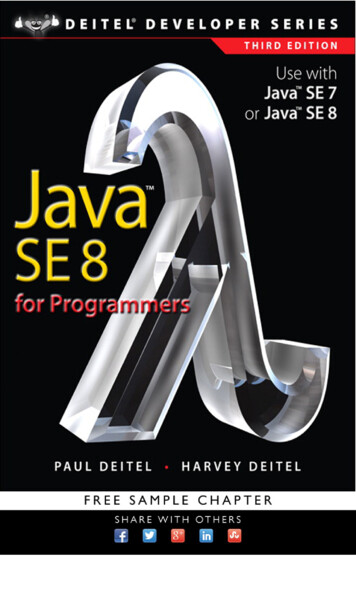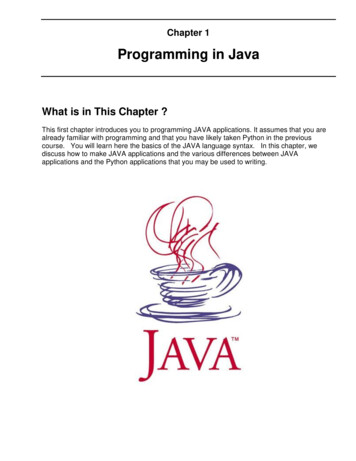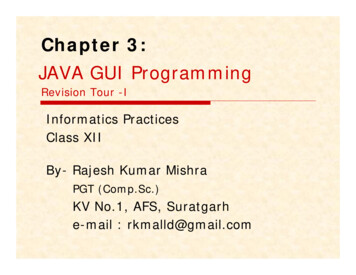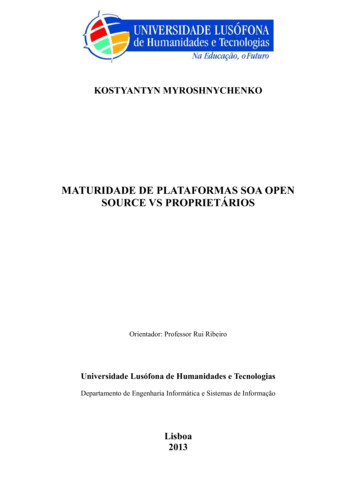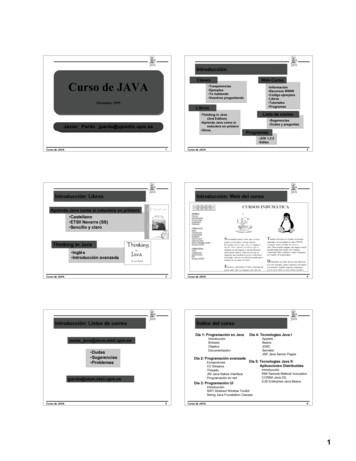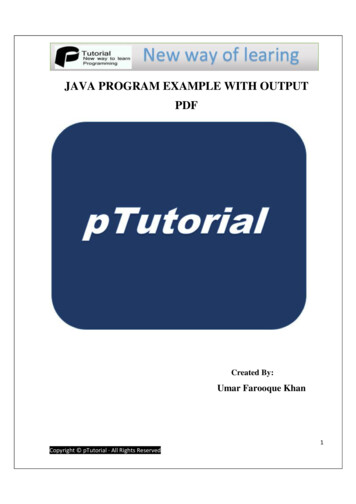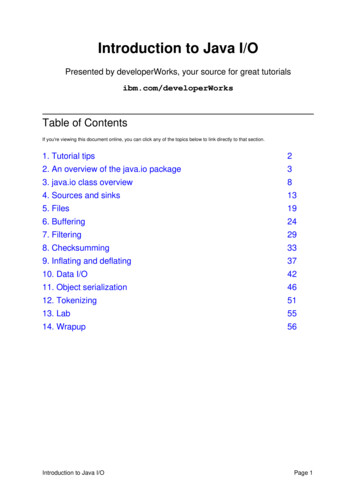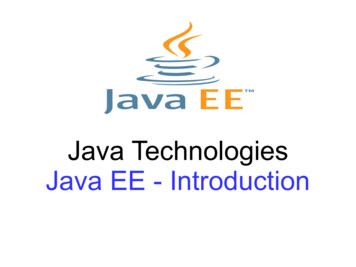
Transcription
Java TechnologiesJava EE - Introduction
First of All – Course Information The Goal The Motivation Teaching / Learning Bibliography Evaluation–Lab: problems, personal projects, essays easy–Exam: written test / quiz hard–Research Projects
Labs Each week a problem will be proposed, related to thecurrent course.The solution to the problem must be presented within3 (three) weeks, during the classes. A solution may receive 1 to 5 points. Teams are not allowed. You must create a private GIT repository, where youwill store your projects.Before each lab, you must send an email containing ashort description of your work on the current problem(along with the git url).
Projects The topic of the project will be announced(approved) in the first half of the semester.The projects will be presented and evaluated inthe last week of the semester. A project may receiceve up to 30 points. Teams are allowed. If the project is presented in the form of ascientific article and prepared to be sent to aconference, it may receive an additional 10points and may be continued as a disertationthesis (contact me for details).
Exam Entry: 30 points at lab project 10 points for participation 20 short-answer questions, each worth 1 point On-site? No documentation :) Grand total: 70% lab project, 30% exam
Enterprise Applications (EA) EA Software system designed to operate in a corporateenvironment such as business or government: targets anorganization rather than individual users.Complex, large-scale, mission critical, portable,scalable, reliable, secure, transactional, distributedsystem.EA software consists of a group of applications sharingvarious resources (users, clients, data, etc.) andintegrating core business processes: sales, accounting,finance, human-resources, inventory and manufacturing,document management, etc.Martin Fowler: "EAs are about the display, manipulation,and storage of large amounts of often complex data andthe support or automation of business processes with thatdata."
Types of EAs Business Intelligence (BI)Business Process Management (BPM)Content Management System (CMS)Enterprise Data Warehousing (EDW)Customer Relationship Management (CRM)Enterprise Resource Planning (ERP)Enterprise Asset Management (EAM)Human Resource Management (HRM)Knowledge Management (KM)Product Data/Information/Lifecycle ManagementSupply Chain Management (SCM).
Java Enterprise Edition(Java EE)“The aim of the Java EE platform is to provide developers with apowerful set of APIs while shortening development time, reducingapplication complexity, and improving application performance.” SpecificationsJava EE API describes how an enterprise application should becreated, what components should contain, etc. Implementations Application Servers–GlassFish (reference implementation), Payara–WebLogicServer, JBoss Application Server / WildFly,IBM WebSphere, Apache Tomcat / Geronimo / TomEE, etc. Portability
J2EE to Jakarta EE J2EE (1999) 1.2, 1.3, 1.4 Java EE (2006) 5,6,7,8In 2017, Oracle decided to give away the rightsfor Java EE to the Eclipse Foundation. Jakarta EE (2019) 8,9
https://jakarta.ee/about/ The Future of Cloud Native JavaFor many years, Java EE has been a major platform for mission-critical enterpriseapplications. In order to accelerate business application development for a cloudnative world, leading software vendors collaborated to move Java EE technologies tothe Eclipse Foundation where they will evolve under the Jakarta EE brand. What is Jakarta EE?Jakarta EE is a set of specifications that enables the world wide community of javadevelopers to work on java enterprise applications. The specifications are developedby well known industry leaders that instills confidence in technology developers andconsumers. Jakarta EE specifications are either grouped into a platform specification(Full or Web Platform) or can be an individual specification. APIs and SpecificationTechnology Compatibility Kit (TCK) - used for testing the code implemented basedon the APIs and Specification documentCompatible Implementation - implementation that successfully passes the TCKCommunity-based specification process
Monolith vs Microservices Monolithic architecture - the application is built as asingle and indivisible unit: client-side user interface,server side-application (components, services,business logic, data repositories, etc) Develop, test, deploy- Understand, update, flexible, scale Microservices architecture – the application is splitinto small, independent modules Agile- Complex
Eclipse MicroProfile Optimizing Enterprise Javafor a Microservices ArchitectureA collection of Java EE APIs and technologieswhich together form a core baselinemicroservice that aims to deliver applicationportability across multiple runtimes. REST, JSON, JAX-RS, CDI. Standard Implementations: Payara Micro, Quarkus,OpenLiberty, Websphere Liberty, WildFly,TomEE, etc.
Downloads NetBeans IDE–Bundle: Java EE or All–Includes Tomcat and GlassFish Application Servers–FreeEclipse IDE for Java EE Developers–An application server must be installed separately–FreeIntelliJ IDEA Ultimate Edition–Free 30 day trial / Free for students and teachers
Admin Console (Glassfish)
Java EE Technologies Servlets JSP Java Server Pages JSF Java Server Faces JNDI Java Naming and Directory Interface JPA Java Persistence API EJB Enterprise Java Beans JAX-WS, JAX-RS Web Services CDI Context and Dependency Injection JMS, JTA, .
Client- vs Server CentricWeb Frameworks In both cases, the bussiness logic is implementedusing server-side components (or services)Server - Centric (JavaEE approach)–The UI component tree is stored on the server and renderedto the client upon page requests.–Binding UI components and server-side data is easy, (clientand server are synchronized)Client – Centric (Angular, React, Vue Services)–The UI is written in JavaScript (or TypeScript, etc) and runson the client (browser)–UI communicates with server-side services in order toreceive and send data
A Note about Spring Framework JavaEE is a set of specifications supervised by TheEclipse Foundation (having various implementations) /Spring is an application framework developed byPivotalSoftware.Both depend on the same core APIs (Servlet, JPA, JMS,BeanValidation etc).They look and behave pretty similar to each other.Spring is more “friendly” to beginners, offering a lot ofready-to-use tools (like SpringBoot, for example).JavaEE offers “heavy guns” (like EJB, for example) forachieving scalability in a standard mannerBoth are “relevant”, being used in large projects and arehere to stay for a long time.
Distributed Multitiered ApplicationsApplication logic is divided into components according to function, and the applicationcomponents that make up a Java EE application are installed on various machines dependingon the tier in the multitiered Java EE environment to which the application component belongs.
Java EE Components Java EE applications are made up of components.A Java EE component is a self-contained functionalsoftware unit that is assembled into an application at aspecific tier and communicates with other components.Client Tier: application clients, appletsWeb Tier: Java Servlet, JavaServer Faces, andJavaServer Pages (JSP) technology components,HTML, XHTML, CSS, etc Bussiness Tier: EJB components (enterprise beans) Model Tier: The entity beans or any other beans :)
Containers“Containers are the interface between a component and thelow-level platform-specific functionality that supports thecomponent. Before a web, enterprise bean, or applicationclient component can be executed, it must be assembled into aJava EE module and deployed into its container.” Web containers manages the execution of web pages,servlets, etc. Implemented in most application servers,such as Tomcat: “Apache Tomcat is an open source software implementation of theJava Servlet, JavaServer Pages, Java Expression Language and Java WebSockettechnologies. The Java Servlet, JavaServer Pages, Java Expression Language and JavaWebSocket specifications” Java EE containers manages the execution of EJB, JMS,etc. and are implemented in the “heavy” Java EE servers,such as Glassfish: “GlassFish is the reference implementation of Java EE and assuch supports Enterprise JavaBeans, JPA, JavaServer Faces, JMS, RMI, JavaServer Pages,servlets, etc.”
Application Lifecycle Develop the components code and the applicationdeployment descriptors, if necessary.Compile the application components and helperclasses referenced by the components.Package the application into a deployable unit. war, ear Deploy the application into dedicated containers,using the application server tools.Access a URL that references the web application.
Organizing the Components Source Level: Java EE blueprints Build Level\MyApplicationWeb PagesResources\WEB-INFweb.xmlConfiguration filesweb.xml the deployment descriptor file:determines how URLs map to components,which URLs require authentication, etc.\classes.class, .properties\lib.jarA "web application" is a collection ofservlets and content installed under aspecific subset of the server's URLnamespace such as /MyApplication andinstalled via a .war file
“Classical” Web Components Servlets Web Filters Web Listeners–Asynchronous Servlets Java Beans Java Server Pages (JSP) Custom Tag Libraries (CTL) Java Standard Tag Library (JSTL)
Bibliography The Java EE Tutorial The Java EE API Additional resources will be provided at eachlab
Java EE Components Java EE applications are made up of components. A Java EE component is a self-contained functional software unit that is assembled into an application at a specific tier and communicates with other components. Client Tier: application clients, applets Web Tier: Java Servlet, JavaServer Faces, and


